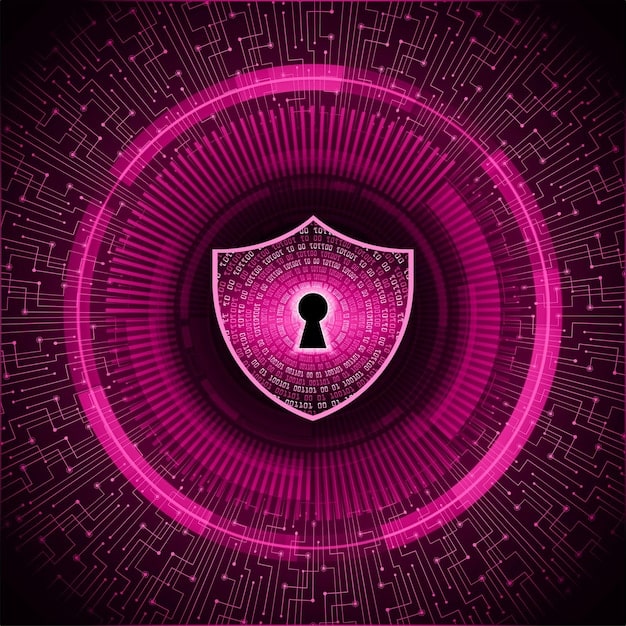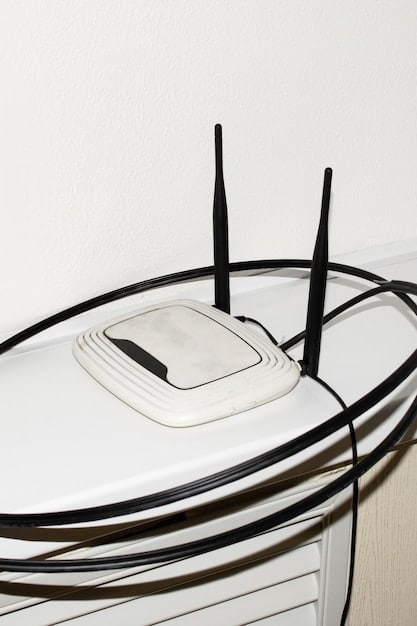Stay Safe Online: US Cybersecurity Recommendations for 2024

Anúncios
Staying safe online requires understanding and implementing the latest cybersecurity recommendations, especially in the US, where digital threats are constantly evolving, necessitating proactive measures.
In today’s digital age, ensuring your online safety is more critical than ever. With the increasing sophistication of cyber threats, understanding and implementing the latest cybersecurity recommendations is essential, especially for those living in the US. This article provides a comprehensive guide on how to stay safe online with the latest US cybersecurity recommendations.
Anúncios
Understanding Current Cybersecurity Threats in the US
The landscape of cybersecurity threats in the US is constantly evolving, presenting new challenges for individuals and organizations alike. Understanding these threats is the first step in protecting yourself online, ensuring your digital life remains secure.
Common Types of Cyber Threats
Cyber threats come in many forms, each designed to exploit vulnerabilities in systems and human behavior. Recognizing these threats is crucial for effective prevention.
Anúncios
- Phishing: Deceptive emails, messages, or websites designed to trick individuals into providing sensitive information.
- Malware: Malicious software, including viruses, worms, and ransomware, that can damage devices and steal data.
- Ransomware: A type of malware that encrypts a victim’s files, demanding a ransom payment for their release.
- Identity Theft: The fraudulent use of personal information to assume someone else’s identity for financial gain.
The Impact of Cyber Threats
The impact of cyber threats can be devastating, leading to financial losses, reputational damage, and emotional distress. Understanding the potential consequences can motivate individuals to take proactive measures.
Cyber threats can affect individuals, businesses, and even critical infrastructure. The cost of cybercrime in the US is estimated to be in the billions of dollars annually, highlighting the severity of the problem. Moreover, data breaches can expose sensitive personal information, leading to identity theft and financial fraud.
In conclusion, understanding the current cybersecurity threats in the US is vital for protecting yourself and your data. By recognizing common types of threats and their potential impact, you can take proactive steps to mitigate the risks and maintain a secure online presence.
Implementing Strong Password Practices
Passwords are the first line of defense against unauthorized access to your online accounts and personal information. Implementing strong password practices is crucial for maintaining online security and preventing cyberattacks.
Creating Strong and Unique Passwords
A strong password is one that is difficult for hackers to guess or crack. Creating such passwords requires a combination of length, complexity, and uniqueness.
- Length: Aim for passwords that are at least 12 characters long.
- Complexity: Use a combination of uppercase and lowercase letters, numbers, and symbols.
- Uniqueness: Avoid using the same password for multiple accounts.
Password Managers: A Secure Solution
Managing multiple strong passwords can be challenging, but password managers provide a secure and convenient solution.
Password managers are software applications that securely store your passwords and automatically fill them in when you visit websites. They also generate strong, unique passwords for each of your accounts, reducing the risk of password reuse. Popular password managers include LastPass, 1Password, and Dashlane.
Two-Factor Authentication (2FA): Adding an Extra Layer of Security
Two-factor authentication adds an extra layer of security to your accounts by requiring a second form of verification in addition to your password.
When you enable 2FA, you’ll need to enter a code sent to your phone or generated by an authenticator app each time you log in. This makes it much harder for hackers to access your accounts, even if they have your password. Many online services, such as Google, Facebook, and Amazon, offer 2FA as an option.
In conclusion, implementing strong password practices is essential for protecting your online accounts and personal information. By creating strong and unique passwords, using a password manager, and enabling two-factor authentication, you can significantly enhance your online security.
Securing Your Home Network
Your home network is the gateway to your online activities, making it a prime target for cybercriminals. Securing your home network is essential for protecting your devices and personal information from unauthorized access.
Changing Default Router Credentials
Routers come with default usernames and passwords that are widely known. Changing these default credentials is one of the first steps in securing your home network.
Access your router’s settings by typing its IP address into your web browser. The default IP address is often printed on the router itself or in its documentation. Once logged in, change the default username and password to something strong and unique.
Enabling Wi-Fi Encryption
Wi-Fi encryption protects your wireless network by scrambling the data transmitted between your devices and the router. Enabling Wi-Fi encryption prevents unauthorized users from eavesdropping on your online activities.
- WPA3: The latest and most secure Wi-Fi encryption protocol.
- WPA2: A widely used and relatively secure encryption protocol.
Keeping Router Firmware Updated
Router firmware is the software that controls your router’s functions. Keeping your router firmware updated is essential for patching security vulnerabilities and maintaining optimal performance.
Most routers offer automatic firmware updates, which can be enabled in the router’s settings. Alternatively, you can manually download and install firmware updates from the manufacturer’s website.
In conclusion, securing your home network is crucial for protecting your online activities and personal information. By changing default router credentials, enabling Wi-Fi encryption, and keeping router firmware updated, you can create a secure and private home network.
Protecting Your Devices from Malware
Malware, or malicious software, can compromise your devices and steal your personal information. Protecting your devices from malware is essential for maintaining online security and preventing cyberattacks.
Installing and Maintaining Antivirus Software
Antivirus software is designed to detect and remove malware from your devices. Installing and maintaining antivirus software is a fundamental step in protecting against cyber threats.
Choose a reputable antivirus program and keep it up to date. Popular options include Norton, McAfee, and Bitdefender, but also Windows Defender is usually enough.
Being Cautious of Suspicious Emails and Websites
Phishing emails and malicious websites are common methods used by cybercriminals to distribute malware. Being cautious of suspicious emails and websites is essential for preventing malware infections.
- Verify Sender: Check the sender’s email address for any inconsistencies or red flags.
- Avoid Clicking Links: Be wary of clicking on links in emails from unknown senders.
- Look for HTTPS: Ensure that websites use HTTPS, indicating a secure connection.
Regularly Backing Up Your Data
Backing up your data is essential for recovering from malware infections and other data loss events. Regular backups ensure that your important files and documents are protected.
Use cloud storage services, external hard drives, or other backup methods to regularly copy your data. Aim to back up your data at least once a week, or more frequently if you make frequent changes to your files.
In conclusion, protecting your devices from malware is crucial for maintaining online security and preventing data loss. By installing and maintaining antivirus software, being cautious of suspicious emails and websites, and regularly backing up your data, you can significantly reduce your risk of malware infections.
Staying Safe on Social Media
Social media platforms are a popular way to connect with friends, family, and colleagues, but they also pose security risks. Staying safe on social media is essential for protecting your personal information and preventing identity theft.
Adjusting Privacy Settings
Social media platforms offer a variety of privacy settings that allow you to control who can see your posts, profile information, and activity. Adjusting these settings is essential for maintaining your privacy.
Review your privacy settings regularly and make sure that only people you trust can access your personal information. Consider limiting the visibility of your posts to friends and family only.
Being Mindful of What You Share
Sharing too much personal information on social media can make you vulnerable to identity theft and other cybercrimes. Being mindful of what you share is essential for protecting your privacy.
- Avoid Sharing Sensitive Information: Don’t post your address, phone number, or financial information on social media.
- Think Before You Post: Consider the potential consequences of sharing certain information.
Avoiding Suspicious Links and Messages
Cybercriminals often use social media to distribute malware and phishing scams. Avoiding suspicious links and messages is essential for protecting yourself from these threats.
Be wary of clicking on links in messages from unknown senders. Verify the authenticity of messages before responding to them. Report any suspicious activity to the social media platform.
In conclusion, staying safe on social media requires adjusting privacy settings, being mindful of what you share, and avoiding suspicious links and messages. By taking these precautions, you can protect your personal information and prevent cybercrime on social media platforms.
Keeping Software Updated
Software updates often include security patches that address vulnerabilities exploited by cybercriminals. Keeping your software updated is essential for maintaining online security and preventing cyberattacks.
Enabling Automatic Updates
Many software applications offer automatic updates, which can be enabled in the program’s settings. Enabling automatic updates ensures that you always have the latest security patches and bug fixes.
Check the settings of your operating system, web browser, and other software applications to enable automatic updates. This will help you stay protected against the latest cyber threats.
Regularly Checking for Updates
Even if you have enabled automatic updates, it’s still a good idea to regularly check for updates manually. This ensures that you don’t miss any important security patches or bug fixes.
Visit the software vendor’s website or use the program’s built-in update feature to check for updates. Install any available updates promptly.
In conclusion, keeping your software updated is crucial for maintaining online security and preventing cyberattacks. By enabling automatic updates and regularly checking for updates manually, you can ensure that your devices are protected against the latest threats.
| Key Point | Brief Description |
|---|---|
| 🔑 Strong Passwords | Use unique, complex passwords & password managers. |
| 🏠 Secure Home Network | Change default credentials, enable Wi-Fi encryption. |
| 🛡️ Malware Protection | Install antivirus, avoid suspicious links. |
| 📱 Social Media Safety | Adjust privacy settings, be mindful what you share. |
FAQ
Phishing is one of the most common cyber threats in the US, targeting users with deceptive emails and messages to steal sensitive information.
Updating your router’s firmware patches security vulnerabilities, protecting your home network from potential cyberattacks and ensuring optimal performance.
You should back up your data at least once a week, or more frequently if you make frequent changes to your files, to prevent data loss.
2FA adds an extra layer of security by requiring a second verification code, making it harder for hackers to access your accounts, even with your password.
Avoid clicking on suspicious links, verify the authenticity of messages, and report any suspicious activity to the social media platform to stay safe.
Conclusion
Staying safe online in the US requires a proactive and informed approach. By implementing strong password practices, securing your home network, protecting your devices from malware, staying safe on social media, and keeping your software updated, you can significantly reduce your risk of cyberattacks and protect your personal information.







